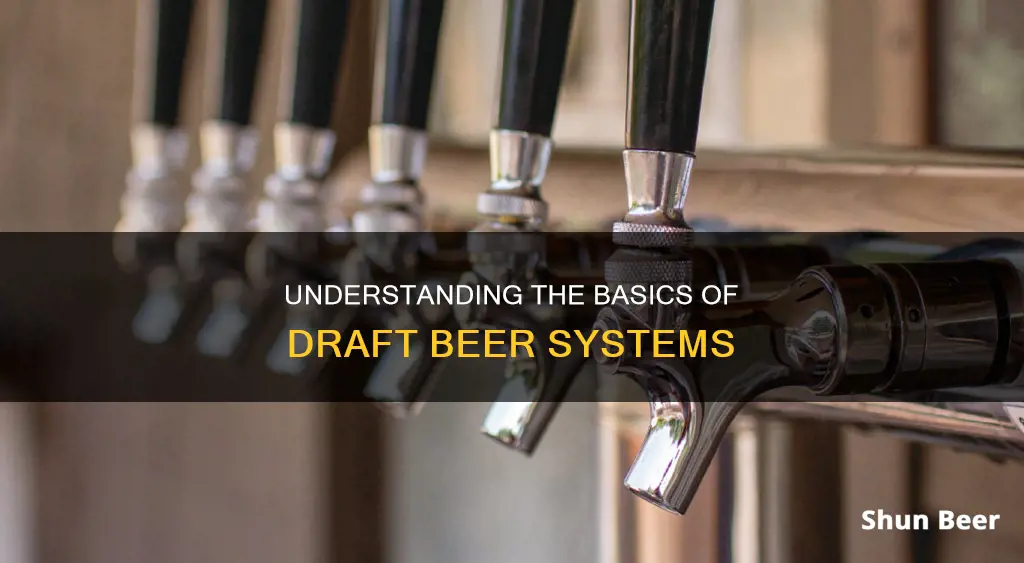
A basic draft beer system is made up of six main components: a cooler, keg, coupler, gas, tubing, and faucet. The keg is where the beer is stored, and it needs to be kept cool to prevent spoilage and foamy pours. The coupler is a key-like adapter that connects the keg to the gas line, allowing gas (usually carbon dioxide) to push the beer out of the keg and into the tubing, which carries it to the faucet, from which it is dispensed. The gas cylinder is usually made of aluminium and comes in various sizes depending on how much beer is being served. The faucet is typically made of chrome-plated brass or stainless steel and has a tap handle that controls the flow of beer.
What You'll Learn

The role of the cooler
The cooler is an essential component of a draft beer system as beer needs to be kept cold not only to taste good but also to ensure it does not spoil. Kegs should be kept cool at a constant temperature of 34-38°F (around 3.3-3.8°C). Most coolers will have a thermostat to regulate the temperature.
There are different types of draft beer systems, but all require the beer to be kept cool. In a direct draw system, the keg is kept in a cooler, along with the beer lines and other components, and the faucet is mounted directly to the cooler. In a long-draw system, the cooler can be located further away from the taps, and an additional refrigeration unit is used to maintain the temperature of the beer as it travels to the tap.
In a glycol-cooled system, a mixture of glycol and water is pumped through a trunk line to keep the beer at a consistent temperature. In an air-cooled system, chilled air is blown through a duct containing the beer lines to keep the beer cool.
The type of cooling system used will depend on the distance between the keg and the tap, as well as the desired temperature of the beer. It is important to ensure that the beer is not too warm or too cold, as this can affect the carbonation and pouring consistency.
Miller Beer Text Rebates: How Do They Work?
You may want to see also

Kegs, their taps and couplers
Kegs are containers for holding and storing beer. They come in various sizes, ranging from 1/6 barrel (5 gallons) to 1/2 barrel (15.5 gallons). Kegs can be made of stainless steel or aluminium, with the former being the most common material due to its rust-resistant and insulating properties. To keep the beer fresh, kegs should be kept cool at a constant temperature of 38°F.
Keg couplers are one of the most important components of a kegerator. They act as a key to unlock and dispense beer. They are attached to the keg valve and air line to release compressed CO2 (or nitrogen) into the keg, forcing the beer out. There are six distinct varieties of keg couplers, each with specifications to accommodate different kinds of beer. The most commonly used types are the D-type (American Sankey) coupler and the A-type (German keg coupler).
Keg taps, or couplers, are connected to what is known as the spear inside the keg. The gas from the beer gas tank pushes the beer from the keg out into the beer line. Most draft beer systems use CO2, but for certain beers such as dry stouts, nitrogen (N2) is required instead.
The choice of keg coupler depends on the type of keg and beer being used. For example, the D-type keg coupler is suitable for US Sankey keg valves, while the S-type keg coupler is designed for European Sankey keg valves. Using the wrong coupler can result in beer spilling out instead of entering the beer line for distribution.
Does Helium Beer Work? The Science Behind It
You may want to see also

Gas and gas cylinders
Gas is a crucial component of any draft beer system, as it propels the beer from the keg to the faucet. Carbon dioxide (CO2) or a mixture of nitrogen and CO2, known as beer gas, is used to push the beer through the beer line to the draft tower and faucet. The gas is stored in pressurised tanks or cylinders, and the amount of pressure can be controlled by the operator using a regulator.
When choosing a gas cylinder, it is important to consider the size and portability of the cylinder, as well as the amount of gas it can hold. Smaller cylinders, such as the popular 2.6kg CO2 cylinder, are convenient for camping, parties, or placing inside a kegerator. Larger cylinders may be more suitable for commercial or long-draw draft systems. It is also important to ensure that the gas cylinder meets the required quality and safety standards.
The type of gas used can also vary depending on the specific requirements of the beer. For example, nitrogen is less soluble in beer than CO2, so it can be used to push the beer without being absorbed as carbonation. This is particularly useful in systems that require higher pressures, such as those with long distances between the kegs and faucets, or when pouring beer at higher elevations.
Proper maintenance of the gas cylinders and related equipment is essential to ensure the beer tastes great and to prevent issues such as foamy pours or overcarbonation. Regular cleaning and replacement of components, including the gas cylinders, regulators, and tubing, are necessary to maintain a well-functioning draft beer system.
Tanning with Beer: Does It Work?
You may want to see also

Gas lines and regulators
The regulator is a crucial device that connects the gas cylinder to the air tube, controlling the flow of gas from the cylinder to the keg. It allows for adjustments to be made to the gas pressure, ensuring the beer is dispensed at the correct pressure. The primary regulator is the most standard option, intended to regulate CO2 or nitrogen, and has at least one gauge that measures the output pressure in pounds per square inch (PSI). This gauge shows how much gas pressure is being used to dispense the beer.
The regulator also includes a shut-off valve, which allows for the quick cessation of gas flow, and a safety relief valve that prevents over-pressurisation by automatically stopping the gas flow. Some regulators feature a pressure relief valve that can be pulled to release gas from the system.
There are two types of primary regulators: single-gauge and double-gauge. Single-gauge regulators only have an output pressure gauge, while double-gauge regulators also have a tank pressure gauge that indicates how much gas remains in the tank. While the output pressure gauge is crucial for dispensing beer, the tank pressure gauge is helpful but not essential.
If multiple kegs are being dispensed from a single gas source, a secondary regulator may be required to adjust the pressure for each keg individually. This is important as different beers often require different dispensing pressures to maintain their intended carbonation levels. Secondary regulators have multiple adjustment screws and hose nipples, allowing for the dispensing of multiple kegs using a single gas source.
The proper regulation of gas pressure is critical in maintaining the quality and flavour of the beer. It helps control carbonation levels, ensuring the beer has the desired taste, mouthfeel, and presentation. Inconsistent gas pressure can lead to over or under-carbonation, affecting the beer's overall quality. Additionally, regulating gas pressure is a safety measure, as handling pressurised gases can be dangerous and improper pressure can lead to accidents like keg explosions or gas leaks.
Bottom-Fill Beer: How Does It Work?
You may want to see also

Beer lines and faucets
The beer line is where the beer flows from the keg to the faucet. It is usually made of PVC or polyethylene, and its length varies depending on the system design. The diameter of the beer line affects the beer's flow rate, with smaller diameters restricting flow and larger diameters having less restriction. The beer line is kept cold by the cold air in the walk-in cooler.
The beer line is connected to the faucet by the shank. The shank is a chrome-plated brass tube with external threading that runs through the hole in the draft tower or the side of the fridge. The faucet is then screwed onto the front end of the shank, and the beer line is attached to the back end. The standard North American shank is ⅞-inch x 14 straight pipe thread and will work with all North American faucets.
The faucet is the tap that the beer is dispensed from. Draft faucets are available in a wide range of different quality levels and with a host of different features. It is important to keep the faucet and handle clean to avoid contamination, which can result in bad-tasting beer. The tap handle or faucet handle is the lever that screws into the draft beer faucet to make it easier to open and close the faucet when pouring.
Chilling Beer Fast: How Do Chiller Sticks Work?
You may want to see also
Frequently asked questions
The essential components of a basic draft beer system are the cooler, keg, coupler, gas, tubing, and faucet.
A basic draft beer system works by using gas (usually carbon dioxide) to push beer from a keg through tubing to a faucet, where it is dispensed. The gas is pressurized and enters the keg through a coupler, which is like a "key" that fits into the keg valve, or "lock". The beer is pushed through the tubing, which is usually made of vinyl or polyethylene, to the faucet, where it is poured into a serving vessel.
There are three standard systems for dispensing draft beer: direct draw, long draw glycol-cooled, and long draw air-cooled. The direct draw system is the most common and straightforward, typically used when the keg is located within a few feet of the dispensing faucet. The long draw glycol-cooled system uses a glycol chiller or power pack to pump a mixture of glycol and water through a trunk line to keep the beer at a consistent temperature as it travels from the keg to the tap. The long draw air-cooled system uses chilled air blown through a duct containing beer lines to keep the beer cooled.







